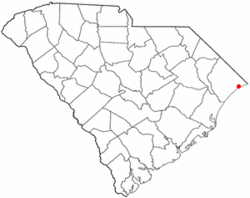Briarcliffe Acres, South Carolina
| Briarcliffe Acres, South Carolina | |
|---|---|
| Town | |
 Location in South Carolina |
|
| Coordinates: 33°47′21″N 78°44′50″W / 33.78917°N 78.74722°WCoordinates: 33°47′21″N 78°44′50″W / 33.78917°N 78.74722°W | |
| Country | United States |
| State | South Carolina |
| County | Horry |
| Settled | 1950s |
| Government | |
| • Mayor | Gary Pell |
| Area | |
| • Total | 0.7 sq mi (1.7 km2) |
| • Land | 0.6 sq mi (1.7 km2) |
| • Water | 0.0 sq mi (0.0 km2) |
| Elevation | 0 ft (0 m) |
| Population (2000) | |
| • Total | 470 |
| • Density | 719/sq mi (277.9/km2) |
| Time zone | Eastern (UTC-5) |
| • Summer (DST) | Eastern (UTC-4) |
| ZIP code | 29572 |
| Area code(s) | 843 |
| FIPS code | 45-08830 |
| GNIS feature ID | 1227842 |
| Website | townofbriarcliffe.us |
Briarcliffe Acres is a town in Horry County, South Carolina, United States that is between Myrtle Beach and North Myrtle Beach. The population was 470 at the 2000 census.
Briarcliffe Acres is located at 33°47′21″N 78°44′50″W / 33.78917°N 78.74722°W (33.789267, -78.747300). According to the United States Census Bureau, the town has a total area of 0.6 square miles (1.6 km2), all of it land.
Briarcliffe Acres was developed as a retirement community by Kenneth Ellsworth, a native of Briarcliff Manor, New York (from which he took the name of his project), who married Virginia (Ginny) Gasque (pronounced "gas-kwee" or, by some, "gas-kee"). Her family came from the nearby town of Conway, South Carolina. Briarcliffe was one of the first planned communities in the southeast, which is interesting on its own terms, but its story is a window into the whole of the area (not even mentioning the Vereens, in whose home George Washington slept [27 April 1791], and much more besides).
In the early (pre-1930) parts of the last century, the coastal areas of northernmost South Carolina were used mostly as farming sites (the real estate monolith now known as Burroughs and Chapin for decades was named “Myrtle Beach Farms”). Sea breezes washed nutrients on crops planted on sand dunes, much as now is done through roots in hydroponic gardens, and cotton and tobacco thrived; farmers from Loris, Gallivant’s Ferry, Florence and other low-country towns bought land on the coast for practical reasons and then spent summers with their families there, rather than stay in the hellish heat and sand fleas of their main farms.
...
Wikipedia
